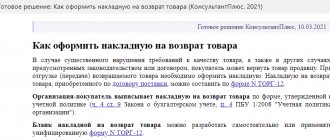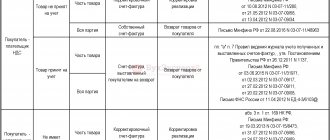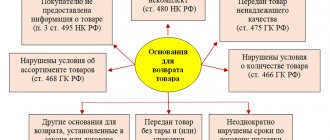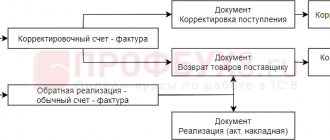Let's consider the situation with returns. These operations always raise many questions. Return is the transfer of goods from the buyer to the seller if facts of improper fulfillment by the seller of their obligations under the purchase and sale agreement listed in the Civil Code of the Russian Federation are revealed.
These are the following cases:
- approval of the order, the seller’s obligation to transfer the goods free from the rights of third parties was violated (Article 460 of the Civil Code of the Russian Federation);
- the seller’s obligation to transfer accessories or documents related to the goods within the period established by the contract has been violated (Article 464 of the Civil Code of the Russian Federation);
- the conditions regarding the quantity of goods were violated (Article 466 of the Civil Code of the Russian Federation);
- the conditions regarding the assortment of goods were violated (clauses 1 and 2 of Article 468 of the Civil Code of the Russian Federation);
- goods of inadequate quality were transferred (clause 2 of Article 475 of the Civil Code of the Russian Federation);
- the packaging of the goods has been violated (clause 2 of Article 480 of the Civil Code of the Russian Federation);
- the conditions for containers and/or packaging of goods were violated (Article 482 of the Civil Code of the Russian Federation).
If the buyer, when returning, does not make any claims to the seller (for quality, suitability, etc.), in accordance with the above-mentioned violations, then this return should be considered a normal sale.
And in this case, the buyer needs to issue an invoice for the shipment of goods received from him in the TORG-12 form. In this article we will focus on returns to the supplier and the reflection of various options in the 1C: Accounting 8 program, edition 2.0.
When accepting goods for accounting, the buyer registers an invoice in the purchase book and VAT is fully deductible (clause 1 of Article 172 of the Tax Code of the Russian Federation), and when returning goods, he issues an invoice to the supplier for the return, which is registered in the sales book.
In the buyer’s accounting, the return of goods is recorded by postings to the debit of account 76.02 “Calculations for claims” and the credit of account 41.01 “Goods in warehouses”.
Sometimes, due to the large turnover, it is inconvenient to allocate calculations for returns to a separate accounting account 76.02, since it will be constantly necessary to make offsets with account 60. Therefore, this article will tell you how you can reflect returns through 60 accounts.
Returns occur in different situations: before or after payment for the goods received. Therefore, we will consider various options.
In our case, we will assume that all goods purchased from the supplier were accepted for accounting on 41 accounts on the balance sheet of the enterprise.
Postings for the return of money and goods in the buyer’s accounting department
If significant deficiencies or defects are identified, the buyer may refuse to fulfill the terms of the contract in full and demand the supplier to return the money paid.
In such a situation, the buyer must send a written claim to the supplier to terminate the contractual relationship with a demand for a refund of the money paid.
The seller, in turn, has the right to return the goods refused by the buyer.
If the need to return the goods and money occurred after the buyer had posted material assets, then if the issue of returning the goods and money is resolved positively, entries will be made in the buyer’s accounting department to the appropriate sub-accounts, based on the claim to the seller and the invoice for the returned goods:
- D-t 62 invoices and K-t 90 invoices - for the amount of the returned goods,
- Invoice Dt 90 and Invoice Dt 68 - VAT is charged on the returned goods.
A refund from the supplier (seller) to the buyer’s bank account for a low-quality product (service) or a product of the wrong assortment will look like this:
- D-t 51 invoices and K-t 62 invoices - for the amount of the invoice issued by the buyer for the return of goods.
If the refund by the seller (supplier) was made directly at the buyer's (customer) cash desk, then the posting of the refund will look like a debit of 50 and a credit of 62 accounts.
How to make a refund in 1s 8.3 accounting
Returns in the Enterprise Accounting 3.0 program can be reflected both to the supplier and returns from the client. Let's consider a situation where a customer returns an item to us.
To reflect the return, go to the sales section, then sales and the item returns from customers. In the form that opens, click on the “Return” button and select “Sale, commission”.
A document will open where we select the counterparty and the contract. To select a sales document, click on the three dots in the shipment document line. A window will appear, select “Sales (act, invoice)” and specify the document.
The tabular part is filled in automatically with all positions from the implementation document.
We leave only one position for return, the rest will be removed.
On the settlements tab, accounts for settlements with counterparties are indicated; they are filled in by default and can be changed if necessary. On the VAT tab, we indicate how this return should be reflected in the purchase book. If we select that as an adjustment invoice, then a field for creating an adjustment invoice will appear at the bottom.
When you select an invoice received from the buyer, a field for entering the invoice number and date will appear at the bottom. After selecting the required method of reflection in the purchase book, we post the document.
From the document you can print the printed forms shown in the figure.
To return funds to the client, click create based on. You can return it in cash or through a bank account.
After selecting the return method, a document will open in which the data has already been filled in.
Refund documents can be created from the bank and cash department section, then bank/cash office, bank statements or cash documents, respectively.
To return goods to the supplier, go to the purchase section and select the item Returns to suppliers. In the window that opens, click on the “Return” button and select “Purchase, commission”.
In the document form that opens, indicate the counterparty and the agreement. Returns can be made using one or more receipt documents. To select documents, click on the three dots in the return by line, document type “Receipt (act, invoice)” and indicate the document.
In the tabular part, we indicate the positions through selection, or from the receipt document by clicking on the “Fill” button.
We leave the positions that will be returned, and remove the rest from the document. On the calculations tab, invoices are filled in by default; you can change them manually. If during the return there will be a different shipper or consignee, we indicate this data on the additional tab.
How this adjustment should be reflected in the sales book is indicated on the VAT tab. After entering the data, we submit the document. At the bottom there is a field for registering an invoice.
From the return document, you can generate the printed forms shown in the figure.
A document for the return of funds from the supplier can be made on the basis of a return document, or in the bank and cash department section, then bank/cash office, bank statements or cash documents. In this case, the transaction type will be “Return from supplier”.
The consultation was prepared for you by a specialist from our Consultation Line.
Order a test consultation on your program with us by phone.
*To provide consultation, you must provide the TIN of your organization, the registration number of your program (for 1C:Enterprise programs of the PROF version, an active 1C:ITS PROF agreement is required)
Refund of erroneously (excessively) paid funds
Refunds of funds transferred to the supplier by mistake are made on the basis of a letter from the customer, which indicates the payment document, its number, date and the amount paid by mistake.
The party that received the erroneous amount reconciles the calculations and deliveries. If excess money is discovered, the supplier returns it to the customer.
In the accounting department of the customer (buyer), the erroneously transferred money is reflected in account 76, the corresponding subaccount.
Posting a refund of funds erroneously transferred to the seller to the customer’s bank account will look like:
- D-t 51 accounts and K-t 76 accounts - in the amount of excessively (erroneously) transferred funds.
The return of money through the customer's cash desk is recorded as turnover on the debit of account 50 and the credit of account 76.
Consultation on accounting entries for financial returns can be obtained from organizations specializing in consulting accountants or tax authorities. Qualified employees of these organizations will answer any questions you may have regarding accounting for the company’s funds.
Documentation of refund to the buyer
According to Article 466 of the Civil Code of the Russian Federation, the buyer has the right to return the goods if they are delivered in quantities less than those provided for in the contracts. If there are discrepancies in the assortment, the return is carried out on the basis of Article 468 of the Civil Code of the Russian Federation. If a product is found to be of inadequate quality, the customer issues a return in accordance with Article 475 of the Civil Code of the Russian Federation.
When returning goods, the buyer draws up the following documents:
- A report on identified discrepancies, drawn up in the TORG-2 form (for imported goods - TORG-3 form). This document is drawn up if, upon shipment of the goods and after payment, the customer identifies deviations in the quality or quantity of products, as well as if inconsistencies are detected in the shipping documents.
- Invoice (form TORG-12), which is used to issue a return if a product is found to be defective or the product does not comply with the approved state or contractual standard.
These documents are transferred to the supplier along with a letter of refund, on the basis of which the supplier accepts the products, and the buyer is credited with the previously made prepayment.
How to return goods from a buyer in 1C BP 3.0?
In what cases can goods and money be returned?
The buyer can return the goods if the terms of the contract are violated (poor quality goods, unspecified quantity, missing components, assortment).
The goods can also be returned by agreement of the parties. If the goods have already been purchased (all the sales documents have been completed), then you need to carry out a reverse sale, but if you decided to carry out the procedure for returning the goods before it was delivered to the warehouse, then the seller will only need to make correctional documents.
In the 1C Accounting 8.3 program, a “Returns from Customers” document is created for such situations.
A document is typically created from an existing implementation of the document.
Important to remember: only goods can be returned, services cannot be returned.
The tabular part of the document will already be filled with all the data (they are pulled up from the implementation itself). The refund can also be partial, in which case it will be enough to correct some of the data manually.
Depending on the situation, we indicate the data in the columns: “Returnable packaging” and “Settlement accounts”.
If we make a return document based on the “Retail Sales Report”, we can create a “Cash Expenditure Order”.
For “Return of goods from the buyer” several printed forms are available: “Return from the buyer”, Help-calculation “Ruble amounts of the document in currency” and “Invoice from the supplier”.
Also in 1C Accounting 8.3, based on this document, we have the opportunity to create several related documents: “Cash issuance”, “Reflection of VAT accrual”, “Reflection of VAT for deduction”, “Payment order”, “Write-off from current account”, “Invoice issued”, “!Invoice received”.
If the buyer of the goods works with VAT:
In this case, the buyer provides a delivery note and an invoice with tax. It is on the basis of these documents that we create a Return from the buyer. Next, the program generates transactions for the return of goods; they will be displayed in red, since this is a cancellation of the transaction:
- Dt 90.02 Kt 41.01 – reversal of sales;
- Dt 62.01 Kt 90.01, Dt 62.02 Kt 62.01 – transactions on mutual settlements with the buyer are reversed;
- Dt 90.03 Kt 19.03 – VAT reversal, after which the debit balance is reflected on account 19.
A receipt is created according to the VAT register presented.
After we register the return invoice, VAT acceptance transactions are generated. From the “VAT presented” register, the VAT amount will be transferred to the “Purchase VAT” register. Regardless of when the goods were sold, it will be reflected in the “Purchase Book of the current period.”
In the current period, this operation will also be displayed in the income tax registers
Subsequently, in 1C Accounting 8.3, the sales of the current period will be reduced by the amount being returned, and the costs of the current period will be reduced by the cost of the product being returned.
If the buyer works without VAT
The Tax Code does not provide the right to deduct VAT when returning goods by the buyer using OSNO. According to the Ministry of Finance, if the buyer uses a VAT exemption or is in a special tax regime, the seller issues an adjustment invoice.
If we need to reflect the return of goods not accepted for registration in 1C Accounting 8.3
In the event that the buyer did not have time to accept the goods for accounting and decided to return it, he is obliged to show it on the balance sheet and, having reached an agreement, return it to the supplier.
Accounting for the return of goods by the seller directly depends on these factors:
- A partial refund is issued using an adjustment invoice (sales adjustment);
- The Treasury Department recommends that you record your full return by recording your own invoice in the Purchase Ledger.
If we need to reflect a partial refund to the seller
In this case, we will need to take the following steps:
- We reflect the receipt of goods - by quality:
- We return defective goods
- We leave in the document the part of the goods that needs to be returned.
If we need to reflect a partial refund to the buyer
We will reflect the following: the purchase adjustment, change the quantity in the document and issue an “Adjustment Invoice”.
VAT is written off in 1C Accounting 8.3 automatically when creating “Purchase Book” entries. Typically this document is issued on the last day of the reporting period. We will see the invoice in the “Purchase Book” of the current period, but only on the date of creation of the Purchase Book entries.
If we return an item that has not been accepted for registration
We can reverse the sale if both the return and the sale take place in the same tax period
Refunds to the buyer: accounting with the customer and the supplier
Let's consider each wiring option.
Return postings from the supplier
Example:
For convenience, let's look at accounting for a return transaction from a supplier using an example. An agreement was concluded between Phobos LLC and Demos LLC for the supply of paint and varnish products, where Phobos is the supplier and Demos is the buyer. The products were sold at a price of 155,000 rubles. at a cost of 88,000 rubles. "Demos" made 100% payment for the goods. Due to non-compliance with the quality characteristics, Demos returned the entire consignment of goods, having issued a TORG-2 act. Upon the return of the products, Phobos credited the previously paid funds to the Demos bank account.
The following entries were made in the accounting of Phobos LLC:
| Dt | CT | Base | Sum | Document |
| 62 | 90/1 | Reflection of revenue from the sale of paint and varnish products | 155,000 rub. | Packing list |
| 90/2 | 43 | Write-off of the cost of paint and varnish products | 88,000 rub. | Costing |
| 90/3 | 68 VAT | VAT accrual on shipped goods | RUB 23,644 | Packing list |
| 51 | 62 | Payment for products has been received from Demos | 155,000 rub. | Bank statement |
| 68 VAT | 51 | VAT transfer | RUB 23,644 | Packing list |
| 10 | 60 | Accounting for returned goods as part of materials | 88,000 rub. | Statement of Discrepancies |
| 19 | 60 | Accounting for VAT on returned goods | RUB 23,644 | Statement of Discrepancies |
| 68 VAT | 16 | Acceptance of returned goods for deduction | RUB 23,644 | Statement of Discrepancies |
| 60 | 51 | LLC "Demos" returned previously paid funds | 155,000 rub. | Discrepancy report, refund letter |
| 91/2 | 60 | Recognition of other expenses (RUB 155,000 - RUB 23,644 - RUB 88,000) | RUB 43,356 | Discrepancy report, delivery note, cost calculation |
Buyer's accounting
To understand what transactions are necessary to reflect the return of funds from the buyer, consider the following example:
According to the agreement, LLC “Faza” supplies LLC “Vector” with goods and materials in the amount of 24 pieces in the amount of 64,000 rubles, VAT 9,762 rubles. Upon delivery, 4 units of goods were found to be defective and were returned to Phase. The cost of defective goods and materials was credited to Vector's account.
The accountant of Vector LLC made the following entries:
| Dt | CT | Description | Sum | Document |
| 60/1 | 51 | Vector LLC paid 100% advance for the goods | 64,000 rub. | Payment order |
| 41 | 60/1 | Inventory items are registered | RUR 54,238 | Packing list |
| 19/3 | 60/1 | VAT accounting | RUB 9,762 | Packing list |
| 68 VAT | 19/3 | VAT deductible | RUB 9,762 | Invoice |
| 76/2 | 41/1 | The defective goods were returned to Faza LLC (4 units) | RUB 9,040 | Statement of Discrepancies |
| 76/2 | 68 VAT | VAT has been restored from the cost of the returned goods | RUB 1,627 | Statement of Discrepancies |
| 51 | 76/2 | A refund was received from Faza LLC for defective products | RUB 10,667 | Bank statement |
It is important to know that if a product discrepancy is identified, refunds for low-quality products are carried out only if all necessary documents are completed in full and correctly.
A refund
When returning previously paid goods and materials, an advance payment is generated from the buyer. Therefore, do not forget to issue an advance invoice for it or return the money spent to the buyer.
How to write out an advance SF for an allocated advance payment when returning paid goods and materials, see topic 16.4. Return of goods from the buyer of the course Accounting and tax accounting in 1C: Accounting 8 ed. 3 from A to Z.
To return non-cash funds, enter the document Write-off from current account . It is more convenient to fill it out from the return document, then it will be filled in automatically.
Return to the buyer - postings in 1C 8.3
We found out how to return a purchase in 1C Enterprise, and using the example of non-cash payments we analyzed the return of funds spent for it.
See also video - Delivery of goods to the buyer: how not to distort costs in 1C: Accounting
How to issue a refund via an online cash register: sample receipt, document flow, rules
Constituent documents, "Cash receipt order" (KO-1), 50 76-3 Receipt of cash: - from equity participation in other organizations. - on account of profits received from joint activities, Decision of participants, shareholders' meetings, "Cash receipt order order" (KO-1) 50 76-2 Receipt of the amount of claims to the organization's cash desk. »
Receipt cash order" (KO-1) 50 79 Receipt of cash from a separate division of the enterprise.
“Cash receipt order” (KO-1) 50 91-1 Sale for cash of fixed assets and other assets. “Cash receipt order” (KO-1) KKM check. 50 91-1 Reflection of positive exchange rate differences (based on changes in the ruble exchange rate against foreign currency held at the organization’s cash desk).
Accounting certificate-calculation 70 50 Issuance of wages from the cash register.
“Cash expenditure order” (KO-2), “Payroll” (T-53).
Forgiveness of an interest-free loan: we charge personal income tax According to the rules in force from 01/01/2016, when issuing an interest-free loan to an employee, personal income tax must be calculated on a monthly basis from the individual’s benefit from saving on interest.
The question arises: what to do with the already accrued tax amounts in the case when the lender forgives the borrower the entire amount of the loan issued. <... Paying tax “for that guy” - a taxpayer’s passport is not required. According to the current rules, you can pay tax not only for yourself, but also for another taxpayer (including an individual). To do this, you just need to fill out the payment form correctly. There is no need to submit any additional documents to the bank. < … Home → Accounting consultations → Accounting Current as of: September 22, 2021
In one of the consultations, we discussed general issues of synthetic and analytical accounting of cash transactions.
One of them is attached to the product report, and the other is given to the buyer and is the basis for receiving money from the cash register. 2
Next, on the check that was previously issued at the same cash desk, sign the director of the organization (deputy).
Then the check needs to be pasted on a piece of paper and handed over to the accounting department. 3
Record the amount paid for a returned customer or unused cash receipt in the cashier-operator's book.
As a result, the amount of revenue for a given day is reduced by the amount received. 4 If the goods are returned not on the day of purchase, but a day later, then the money is returned from the organization’s main cash register, but solely on the basis of a written application from the buyer, indicating his data, and upon presentation of a document that proves his identity.
Accounting entries 50-1 62, 76, 90-1 Reduced by reversing cash register revenue due to the return of money to buyers (clients) on unused cash receipts (including erroneously punched cash receipts) Accounting accounts used in the entries
- 50 — Cash deskAccount 50 “Cash desk” is intended to summarize information about the availability and flow of funds in the organization’s cash desks. Subaccount 50-1 “Cash of the organization” records the funds in the cash desk of the organization. When an organization...
- 62 — Settlements with buyers and customersAccount 62 “Settlements with buyers and customers” is intended to summarize information on settlements with buyers and customers.
Author KakSimply! Situations often arise in the business activities of an organization that sells goods for cash when a dissatisfied buyer returns the goods.
These operations must be “carried out through the cash register”, while strictly observing the procedure for preparing the primary documents.
According to the Law “On the Protection of Consumer Rights”, the buyer has the right to return the product if it suddenly does not fit in size, configuration, style or turns out to be of poor quality. Articles on the topic: Instruction 1 If the buyer, for one reason or another, is already disappointed in it on the day of purchasing the product and decides to return it, then you are obliged to accept it. Document acceptance of the goods with a return certificate in accordance with Form N KM-3, which requires the details of the cash receipt. Draw up the document in one copy and submit it to the accounting department. In addition, issue a delivery note (in two copies).
>Return of cash to the buyer using a posting check Mikhail Obukhov | Labor Law | 03/08/2018 00:20 0 Comments
Options for errors requiring a refund and their consequences
In relations between counterparties, errors in the transfer of funds are possible, associated with:
- with the wrong choice of counterparty when generating a payment order;
- indicating an incorrect payment amount;
- reflection in the purpose of payment of the details of a document that does not exist in the relationship.
Such errors can be identified by any of the parties, but will require a mandatory written expression of the initiative of the payer of funds to take actions carried out in connection with their correction.
In a number of situations, the error can be corrected by adjusting the purpose of the payment if, for example, there is a supplier-buyer relationship between the counterparties, against which an erroneously transferred amount (or a payment with an incorrectly specified purpose) may be taken into account. Correction via payment adjustment cannot be applied if there are no current engagement agreements with the payee.
Regardless of the reason for which the payment was considered to have been made without reason, it is recorded by both the payer and the recipient using the same algorithms, taking into account the fact that for these two parties the transactions when returning the erroneously transferred funds will be mirror images.
Since erroneous transfers subject to refund have no connection with the calculations performed between suppliers and buyers, VAT on them is not allocated either for payment or as deductions. However, if calculations are carried out in foreign currency, then exchange differences attributable to income/expenses may arise. The recipient of the funds, when returning them, in the purpose of payment in the payment document should reflect information that this payment is used to return the funds erroneously transferred to him, and provide a link to the details of the document in which the payer expressed a request to return the money to him.
If the error is corrected by taking into account the transferred amount as payment under another supply agreement, then it will be taken into account in the usual manner for the supplier-buyer relationship with the implementation of the necessary VAT transactions.
Posting a refund
According to current legislation, the seller of goods or service provider is obliged to provide the buyer (customer) with a product (service, work) of the quality and range specified in the contract and allowing the product or the result of the services (work) provided to be used for its intended purpose.
Postings for the return of money and goods in the buyer’s accounting department
If significant deficiencies or defects are identified, the buyer may refuse to fulfill the terms of the contract in full and demand the supplier to return the money paid.
In such a situation, the buyer must send a written claim to the supplier to terminate the contractual relationship with a demand for a refund of the money paid.
The seller, in turn, has the right to return the goods refused by the buyer.
If the need to return the goods and money occurred after the buyer had posted material assets, then if the issue of returning the goods and money is resolved positively, entries will be made in the buyer’s accounting department to the appropriate sub-accounts, based on the claim to the seller and the invoice for the returned goods:
- D-t 62 invoices and K-t 90 invoices - for the amount of the returned goods,
- Invoice Dt 90 and Invoice Dt 68 - VAT is charged on the returned goods.
A refund from the supplier (seller) to the buyer’s bank account for a low-quality product (service) or a product of the wrong assortment will look like this:
- D-t 51 invoices and K-t 62 invoices - for the amount of the invoice issued by the buyer for the return of goods.
If the refund by the seller (supplier) was made directly at the buyer's (customer) cash desk, then the posting of the refund will look like a debit of 50 and a credit of 62 accounts.
Postings for the return of money and goods in the accounting department of the supplier (seller)
The receipt of returned goods in the supplier's accounting department is carried out on the basis of an invoice issued by the buyer for the return of materials (goods):
- D-t 60 invoices and K-t 10, 41 invoices - for the amount of the returned goods,
- Invoice Dt 19 and Invoice Dt 60 - VAT is reflected on the returned goods.
A refund to the buyer’s bank account for a low-quality product or product of the wrong range from the supplier will look like this:
- D-t 60 invoices and K-t 51 invoices - for the amount of the invoice issued by the buyer for the return of goods.
If the refund to the buyer was made directly at the seller’s cash desk, then the postings will look like debit 60 and credit 50 to the account.
Refund of erroneously (excessively) paid funds
Refunds of funds transferred to the supplier by mistake are made on the basis of a letter from the customer, which indicates the payment document, its number, date and the amount paid by mistake.
The party that received the erroneous amount reconciles the calculations and deliveries. If excess money is discovered, the supplier returns it to the customer.
In the accounting department of the customer (buyer), the erroneously transferred money is reflected in account 76, the corresponding subaccount.
Posting a refund of funds erroneously transferred to the seller to the customer’s bank account will look like:
- D-t 51 accounts and K-t 76 accounts - in the amount of excessively (erroneously) transferred funds.
The return of money through the customer's cash desk is recorded as turnover on the debit of account 50 and the credit of account 76.
Consultation on accounting entries for financial returns can be obtained from organizations specializing in consulting accountants or tax authorities. Qualified employees of these organizations will answer any questions you may have regarding accounting for the company’s funds.
Return of goods in 1C 8.3 from the buyer
Let's see how to make a return to 1C using an example, and analyze each of the options.
Since the buyer had no demand for the previously sold goods, the parties agreed to return part of the batch (3 pieces). The return is processed within the framework of the previous contract.
On February 14, the returned inventory items were capitalized, and the buyer received an adjustment invoice for them.
Return of goods from the buyer
Capitalize the returned goods and materials using the document Return of goods from the buyer . Fill it out with all the necessary information based on the sale of goods. To fill it out manually, create it in the Sales – Returns from Customers section.
When returning an incomplete batch, specify the number of goods and materials returned to the warehouse.
When setting the CSF, leave the recommended value on the VAT and write it down.
When selling goods back, put the switch on Invoice received from the buyer . Then fields will appear for filling out the SF data and registering it in the database.
Postings
If you need to reflect mutual settlements on another account, set a new account on the Settlements .
Implementation adjustments
Let's create the same example using a different option.
Based on the sales, fill out the Sales Adjustment document or go to the Sales – Sales Adjustment section to fill it out manually.
Correct the Quantity column (after change) , reflecting the actual quantity of goods and materials sold to the buyer after the return is reflected.
Postings
Since accrued VAT on returned goods is not automatically deductible, complete this operation yourself. To do this, go to the Operations section - Regular VAT operations and select Create - Generating purchase ledger entries.
To automatically fill in VAT on the Reducing sales cost , use the Fill and check the amount of VAT accepted for deduction.
Differences in return processing methods
There is no big difference in registration for an accountant. But if the return is processed by managers, it is more convenient to use the document Return of goods from the buyer .
The return of other goods and materials does not have any special differences and is carried out in the same ways.







